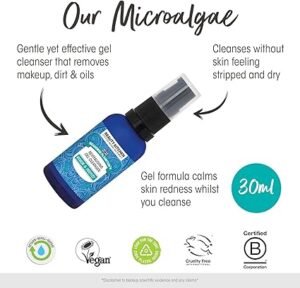
Sustainability in Beauty: How it Started and Where it’s Going
By Anna McLean
The beauty industry has seen a remarkable transformation over the past few decades, with sustainability becoming a focal point for brands and consumers alike. What began as a niche movement has evolved into a mainstream priority, driving significant changes in how beauty products are formulated, packaged, and marketed. In this blog, we’ll delve into the history of sustainability in beauty, explore current trends, and recommend eco-conscious products available on Amazon UK to help you make greener choices in your beauty routine.
The Origins of Sustainable Beauty
Early Awareness and Activism
The journey towards sustainability in beauty can be traced back to the environmental movements of the 1960s and 70s. During this period, growing awareness about pollution and the impact of industrial activities on the planet led to increased scrutiny of consumer goods, including cosmetics.
Rise of Natural and Organic Products
In the 1980s and 90s, the demand for natural and organic products began to rise. Consumers became more concerned about the ingredients in their beauty products, seeking alternatives that were free from harmful chemicals and synthetics. This era saw the emergence of pioneering brands that prioritized natural ingredients and ethical sourcing.
Eco-Friendly Packaging
The turn of the millennium brought heightened awareness about plastic pollution and waste. Beauty brands began exploring eco-friendly packaging solutions, such as recyclable materials, biodegradable containers, and minimalistic designs that reduce excess packaging.
Modern Trends in Sustainable Beauty
Clean Beauty Movement
The clean beauty movement, which emphasizes transparency and safety in product formulations, has gained significant traction. Clean beauty brands avoid controversial ingredients and prioritize non-toxic, skin-friendly components. This trend aligns with the broader sustainability agenda by promoting products that are both safe for consumers and environmentally responsible.
Ethical and Cruelty-Free Practices
Ethical considerations, including cruelty-free and vegan certifications, have become essential for many consumers. Brands are increasingly committing to cruelty-free testing practices and offering vegan product lines, ensuring that their beauty routines do not contribute to animal suffering.
Sustainable Sourcing
Sustainable sourcing practices ensure that ingredients are harvested in ways that do not deplete natural resources or harm local ecosystems. This includes the use of fair trade ingredients, support for small-scale farmers, and adherence to sustainable agriculture practices.
Zero-Waste Initiatives
The zero-waste movement in beauty aims to eliminate waste by encouraging reusable, refillable, and compostable packaging. Brands are innovating with solid products (such as shampoo bars and solid lotions) that reduce the need for traditional plastic containers.
Recommended Sustainable Beauty Products on Amazon UK
Green Beauty Brands
- Burt’s Bees
- Burt’s Bees Beeswax Lip Balm: Made with responsibly sourced beeswax, this lip balm is a favorite for its natural ingredients and recyclable packaging.
- The Body Shop
- The Body Shop Tea Tree Oil: Known for its purifying properties, this tea tree oil is sourced through fair trade practices and comes in recyclable packaging.
Eco-Conscious Skincare Lines
- REN Clean Skincare
- REN Clean Skincare Evercalm Global Protection Day Cream: This day cream is formulated with sensitive skin in mind, using bio-actives from sustainable sources and packaged in recyclable containers.
- Ethique
- Ethique Eco-Friendly Solid Shampoo Bar: Ethique’s solid shampoo bars are plastic-free, vegan, and use sustainably sourced ingredients.
Zero-Waste Beauty
- Beauty Kitchen
- Beauty Kitchen Seahorse Plankton+ Revitalising Gel Cleanser: Packaged in a returnable bottle as part of Beauty Kitchen’s zero-waste initiative, this cleanser is both effective and environmentally friendly.
The Future of Sustainable Beauty
Technological Innovations
As technology advances, so do opportunities for sustainability in beauty. Innovations in biodegradable materials, sustainable manufacturing processes, and biotechnology-derived ingredients are set to drive the future of eco-friendly beauty products.
Consumer Education and Advocacy
Educated consumers are the catalyst for change. Continued efforts to raise awareness about the environmental impact of beauty products and the benefits of sustainable alternatives will help drive demand for greener options.
Regulatory Support
Government regulations and industry standards are evolving to support sustainability initiatives. Policies that encourage the use of safe, sustainable ingredients and mandate eco-friendly packaging are likely to become more prevalent.
Conclusion
Sustainability in beauty has come a long way from its humble beginnings, evolving into a dynamic and influential movement. By embracing green beauty brands and eco-conscious skincare lines, consumers can make a positive impact on the planet while enjoying high-quality beauty products. As technology and consumer advocacy continue to push the boundaries of what’s possible, the future of sustainable beauty looks promising and full of innovation.
Incorporate these sustainable products into your beauty routine and join the movement towards a more environmentally friendly and ethical beauty industry. Your choices today can help shape a greener, more sustainable tomorrow.
Keywords:
Sustainable beauty, eco-conscious skincare, green beauty brands, zero-waste beauty products, clean beauty movement, ethical beauty practices, sustainable sourcing, biodegradable packaging, eco-friendly cosmetics, Amazon UK beauty products









